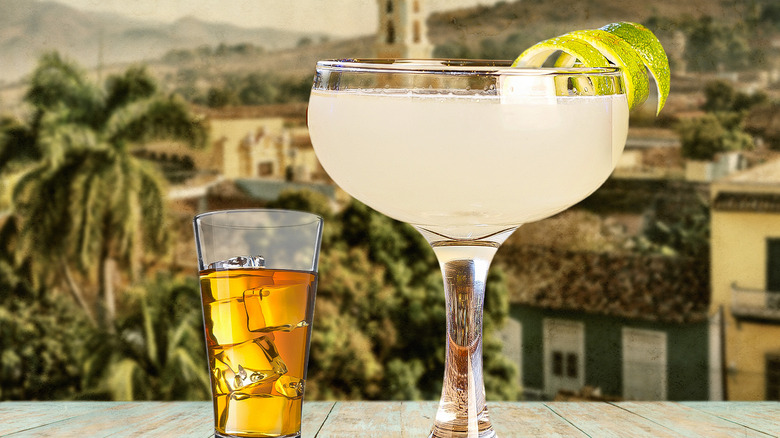The Historic Cuban Connection To The Classic Rum Daiquiri
If the mention of Daiquiris brings to mind frozen drink dispensers, yard-long drink glasses, and multi-hued sweet slush, you'll be surprised to hear how far this venerable drink has veered from its start. Originally a simple, shaken mix of rum, lime juice, and brown sugar, served over ice but not frozen, the drink takes its name from the port city in Cuba where it was made popular by an American engineer in the late 1800s.
In the 1920s, a popular Havana bar began serving the mixture blended and served over shaved ice. That was the start of the Daiquiri's frozen era. The drink migrated to the United States with a naval officer where it slowly gained popularity through the decades. Notably, Ernest Hemingway favored a double-strong version during his time in Cuba, adding to the mystique of the Daiquiri. It's said that JFK marked his 1960 election victory by toasting with Jackie Kennedy's personalized version of the recipe. So how did this rum and lime cocktail transform into a boozy adult slush?
Shake up a classic Daiquiri
During the American Revolution, Caribbean rum held sway as the primary liquor choice only to cede ground to whiskey with the decline of the sugar trade. However, in the post-World War II era, the growing influence of tiki culture and increased international travel rejuvenated interest in rum. Bartenders introduced newly popular tropical flavors that transformed the frozen Daiquiri into the familiar fruity, sweet, poolside concoction popular today. In the current era of craft cocktails, mixologists are revitalizing the classic drink, bringing back the distinct flavors of Cuban rum and fresh lime to the forefront.
The Daiquiri belongs to the sour cocktail family and like its cousins the whiskey sour and margarita, the key to a superb tasting outcome lies in using top-shelf ingredients. A combination of fresh lime juice, premium rum, a judicious amount of sugar, and a good, hard shake will create the bracing cold cocktail that people enjoyed in Cuba over a century ago. For hints of tropical fruit, try a pineapple rum recipe, shaken and served over crushed ice, letting the blender have a rest.

